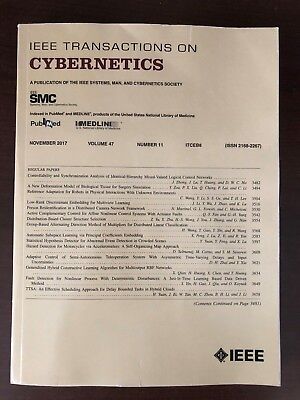Passivity-Based Asynchronous Control of 2-D Roesser Markovian Jump Systems and Stabilization Under DoS Attacks.
IF 10.5
1区 计算机科学
Q1 AUTOMATION & CONTROL SYSTEMS
引用次数: 0
Abstract
The passivity-based asynchronous control is tackled for 2-D Roesser Markovian jump systems (MJSs) and stabilization is guaranteed when 2-D MJSs are susceptible to Denial-of-Service (DoS) attacks. A novel jump model is proposed in this article, where the switching law of subsystems is regulated by the sum of the horizontal and vertical coordinates' values. This differs from the conventional jump model, which presumes that the transition probabilities are identical in both directions. The proposed jump model can avoid the mode ambiguity problem. Given the openness and sharing nature of communication networks, they are susceptible to malicious cyber-attacks that impair system performance. The concept of global time is introduced to help characterize the jump law and construct DoS attack model. Besides, a hidden Markov model (HMM) is utilized to manage the inevitable mismatched mode problem induced by any delay or data dropouts. With the above considerations, several conditions are established for ensuring passivity performance of 2-D MJSs and stabilization when facing DoS attacks. Several equivalent solvable conditions are derived via decoupling strategy and matrix inequality technique. Finally, two simulation examples are provided to demonstrate the validity of the established theoretical results.二维Roesser马尔可夫跳跃系统的无源异步控制及DoS攻击下的镇定。
研究了二维Roesser马尔可夫跳变系统的无源异步控制问题,保证了二维Roesser马尔可夫跳变系统在DoS攻击下的稳定性。本文提出了一种新的跳跃模型,其中子系统的切换规律由横坐标和纵坐标的和来调节。这与传统的跳跃模型不同,后者假设两个方向的转移概率相同。所提出的跳跃模型可以避免模式模糊问题。鉴于通信网络的开放性和共享性,它们很容易受到损害系统性能的恶意网络攻击。引入了全局时间的概念来描述跳转规律,构建DoS攻击模型。此外,利用隐马尔可夫模型(HMM)来管理由于延迟或数据丢失而导致的不可避免的模式不匹配问题。基于以上考虑,建立了几个条件,以确保二维mjs在面对DoS攻击时的被动性能和稳定性。通过解耦策略和矩阵不等式技术导出了几个等价的可解条件。最后,通过两个仿真算例验证了所建立理论结果的有效性。
本文章由计算机程序翻译,如有差异,请以英文原文为准。
求助全文
约1分钟内获得全文
求助全文
来源期刊

IEEE Transactions on Cybernetics
COMPUTER SCIENCE, ARTIFICIAL INTELLIGENCE-COMPUTER SCIENCE, CYBERNETICS
CiteScore
25.40
自引率
11.00%
发文量
1869
期刊介绍:
The scope of the IEEE Transactions on Cybernetics includes computational approaches to the field of cybernetics. Specifically, the transactions welcomes papers on communication and control across machines or machine, human, and organizations. The scope includes such areas as computational intelligence, computer vision, neural networks, genetic algorithms, machine learning, fuzzy systems, cognitive systems, decision making, and robotics, to the extent that they contribute to the theme of cybernetics or demonstrate an application of cybernetics principles.
 求助内容:
求助内容: 应助结果提醒方式:
应助结果提醒方式:


